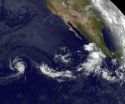(Press-News.org) The Eastern Pacific Ocean is fired up with two tropical storms today, Fernanda and Greg, and both were caught in one image from the GOES-11 satellite. Both appear to be chasing each other to the west, and Fernanda appears a little more organized in satellite imagery and stronger than her "little brother."
The newest tropical storm, Greg, formed this morning, August 17 off the west coast of Mexico from a low previously known as System 99E. Greg is about 135 miles (220 km) south-southwest of Zihuatanejo, Mexico. Because Greg is close to the western coast of Mexico, the National Hurricane Center noted that heavy rainfall is possible in the next day or two along the coasts of two Mexican states: Guerrero and Michoacan.
The Geostationary Operational Environmental Satellite called GOES-11 caught an image of eastern Pacific on August 17 at 1200 UTC (8 a.m. EDT) and showed Fernanda moving into the Central Pacific Ocean while Greg is in the far Eastern Pacific. The image was created at NASA's GOES Project, located at NASA Goddard Space Flight Center in Greenbelt, Md. NOAA manages the GOES-11 satellite and NASA uses its data to create images and animations.
In the image, Fernanda far west of Greg, has a signature shape of a mature tropical storm, while Greg shows high clouds and powerful convection and thunderstorms in the center of circulation, but had not yet fully developed the signature comma shape. The eastern quadrant of Greg's clouds extended over the southwestern Mexico coastline, and his thunderstorms were dropping moderate to heavy rainfall.
On August 17 at 5 a.m. EDT (0900 UTC), Tropical Storm Greg's maximum sustained winds were near 40 mph. Those tropical storm-force winds extend outward up to 45 miles, making the storm 90 miles in diameter. Estimated minimum central pressure is 1004 millibars. Greg was centered near 15.8 North and 102.2 West and moving to the west-northwest near 16 mph (26 kmh). Greg's center is expected to remain well offshore from the southwestern Mexico coastline.
Greg is located in a decent environment for strengthening: moist air, moderate wind shear from the northeast and warm sea surface temperatures near 86 Fahrenheit (30 Celsius). It takes sea surface temperatures of at least 80F (26.6C) to support a tropical cyclone
Tropical Storm Fernanda is stronger than her "little brother" Greg, with maximum sustained winds near 50 mph (85 kmh) and some slight strengthening is still possible, according to the National Hurricane Center. Greg is not only Fernanda's "little" brother in terms of winds but also in terms of extent of tropical storm-force winds. Fernanda's tropical storm-force winds extend out 70 miles from the center making her 50 miles wider in diameter than Greg.
On August 17 at 5 a.m. EDT, Fernanda was still very far from Hawaii. In fact, she was centered about 1,350 miles (2, 715 km) east-southeast of South Point, Hawaii near 11.6 North and 136.9 West. She's moving to the west near 7 mph (11 kmh) and is expected to turn to the west-northwest over the next couple of days. Fernanda is not expected to reach hurricane status as she continues to move west and Greg continues to chase her.
INFORMATION:
GOES-11 satellite sees Tropical Storms Fernanda and 'little brother' Greg chasing each other
2011-08-19
ELSE PRESS RELEASES FROM THIS DATE:
Model shows polar ice caps can recover from warmer climate-induced melting
2011-08-19
A growing body of recent research indicates that, in Earth's warming climate, there is no "tipping point," or threshold warm temperature, beyond which polar sea ice cannot recover if temperatures come back down. New University of Washington research indicates that even if Earth warmed enough to melt all polar sea ice, the ice could recover if the planet cooled again.
In recent years scientists have closely monitored the shrinking area of the Arctic covered by sea ice in warmer summer months, a development that has created new shipping lanes but also raised concerns about ...
Moon and Earth may be younger than originally thought
2011-08-19
LIVERMORE, Calif. -- New research using a technique that measures the isotopes of lead and neodymium in lunar crustal rocks shows that the moon and Earth may be millions of years younger than originally thought.
The common estimate of the moon's age is as old as 4.5 billion years old (roughly the same age as the solar system) as determined by mineralogy and chemical analysis of moon rocks gathered during the Apollo missions. However, Lawrence Livermore National Laboratory scientist Lars Borg and international collaborators have analyzed three isotopic systems, including ...
No bones about it: Eating dried plums helps prevent fractures and osteoporosis
2011-08-19
When it comes to improving bone health in postmenopausal women — and people of all ages, actually — a Florida State University researcher has found a simple, proactive solution to help prevent fractures and osteoporosis: eating dried plums.
"Over my career, I have tested numerous fruits, including figs, dates, strawberries and raisins, and none of them come anywhere close to having the effect on bone density that dried plums, or prunes, have," said Bahram H. Arjmandi, Florida State's Margaret A. Sitton Professor and chairman of the Department of Nutrition, Food and Exercise ...
Study finds majority of pharmaceutical ads do not adhere to FDA guidelines
2011-08-19
A study led by Mount Sinai School of Medicine researchers of 192 pharmaceutical advertisements in biomedical journals found that only 18 percent were compliant with Food and Drug Administration (FDA) guidelines, and over half failed to quantify serious risks including death. The study, is published online today in the journal Public Library of Science (PLoS) One.
"Marketing research has consistently shown that journal advertising is the most profitable form of drug marketing, with an estimated return on investment of five dollars for every dollar spent," said Dr. Deborah ...
23andMe replicates over 180 genetic associations with Web-based research platform
2011-08-19
MOUNTAIN VIEW, CA – (August 17, 2011) – 23andMe, Inc., a leading personal genetics company has replicated over 180 genetic associations from a list of associations curated by the National Human Genome Research Institute's Office of Population Genomics ("GWAS Catalog") demonstrating that self-reported medical data is effective and reliable to validate known genetic associations. The results, available online in the journal PLoS ONE establish 23andMe's methodology as a significant research platform in a new era of genetic research.
"In this paper we confirm that self reported ...
B chromosomes affect sex determination in cichlid fishes
2011-08-19
B chromosomes have a functional effect on sex determination in a species of cichlid fishes from Lake Victoria, according to a study by Japanese researchers to be published in open-access journal PLoS Genetics on August 18th, 2011. The researchers found sex-ratio distortions caused by B chromosomes in the breeding line of the cichlids, as well as several protein-coding genes in the B chromosomes. The resultant ratio was female biased, suggesting a role for B chromosomes in female sex determination.
The B chromosome was first identified by E. B. Wilson in 1907. B chromosomes ...
Mutant gene identified that causes abnormal chromosome count, leading to cancer
2011-08-19
Washington, D.C. – Cells with too few or too many chromosomes have long been known to be a hallmark of cancer — but the cause of this abnormal number of chromosomes has been little understood. Now, in the August 19th issue of Science, researchers at the Georgetown Lombardi Comprehensive Cancer Center, a part of Georgetown University Medical Center, have identified a gene that is commonly mutated in human cancers and have demonstrated its direct role in causing aneuploidy, an abnormal number of chromosomes.
The researchers found that 20 percent of the brain cancer (glioblastoma ...
Further, faster, higher: Wildlife responds increasingly rapidly to climate change
2011-08-19
New research by scientists in the Department of Biology at the University of York shows that species have responded to climate change up to three times faster than previously appreciated. These results are published in the latest issue of the leading scientific journal Science.
Faster distribution changes. Species have moved towards the poles (further north in the northern hemisphere, to locations where conditions are cooler) at three times the rate previously accepted in the scientific literature, and they have moved to cooler, higher altitudes at twice the rate previously ...
Annual cervical cancer screening persists, despite recommended guidelines
2011-08-19
Philadelphia, PA, August 18, 2011 – Investigators from the Centers for Disease Control and Prevention (CDC) have determined that the majority of primary care providers continue to recommend annual cervical cancer screening, and less than 15% would extend the screening interval when using the Papanicolaou test and human papillomavirus (HPV) test together, as some guidelines suggest. The results of the study are published online today in the American Journal of Obstetrics & Gynecology (AJOG).
Current cervical cancer screening guidelines, issued by the American Cancer Society ...
Fishing games gone wrong
2011-08-19
VIDEO:
Before they start attaching themselves to kinetochores (green), microtubules nudge chromosomes (red) into position in a "belt " around the center of the spindle.
Click here for more information.
Heidelberg, 19 August 2011 – When an egg cell is being formed, the cellular machinery which separates chromosomes is extremely imprecise at fishing them out of the cell's interior, scientists at the European Molecular Biology Laboratory (EMBL) in Heidelberg, ...



